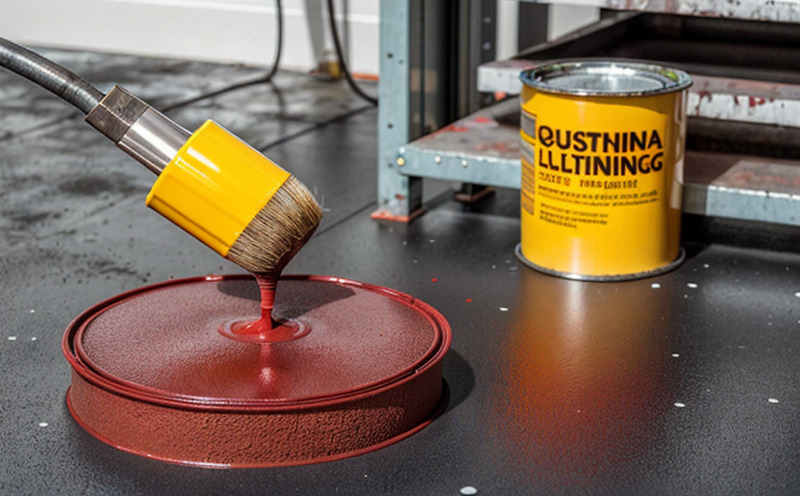EN ISO 4628 Paint Degradation Classification Testing
The EN ISO 4628 standard provides a systematic approach to assessing and categorizing paint degradation. This method is crucial for quality managers, compliance officers, R&D engineers, and procurement professionals involved in the testing of industrial coatings, paints, and surface finishing materials. The standard outlines detailed procedures that ensure consistent results across different laboratories and jurisdictions.
The EN ISO 4628 test involves exposing painted specimens to various environmental conditions, including ultraviolet light, humidity, temperature fluctuations, and artificial weathering cycles. Specimens are then visually inspected for signs of degradation such as chalking, cracking, peeling, and loss of adhesion. The extent and type of degradation are classified into specific categories.
Understanding the degradation process is essential for optimizing product performance in harsh environments. This test helps manufacturers identify the most susceptible areas of their products and improve formulation processes to enhance durability and longevity. Compliance with EN ISO 4628 ensures that products meet international standards, which is critical for export markets and maintaining a competitive edge.
The standard also emphasizes the importance of specimen preparation. Specimens must be representative of the intended use, including appropriate thicknesses and types of substrates. The testing environment should closely mimic real-world conditions to provide accurate and reliable results.
Instrumentation plays a crucial role in this test. Visual inspection is supplemented by more advanced techniques such as colorimetry, gloss measurement, and adhesion tests. These tools help quantify the extent of degradation beyond visual assessment alone. The use of standardized methods ensures that all laboratories can achieve consistent results, which is vital for regulatory compliance.
The classification system in EN ISO 4628 allows for a detailed breakdown of paint degradation into several categories based on observed changes. This categorization provides valuable insights into the performance characteristics of different paints and coatings under various environmental stressors. By understanding these classifications, manufacturers can tailor their products to meet specific market demands and regulatory requirements.
The testing process is designed to be rigorous yet flexible, allowing for modifications as new technologies emerge or as industry needs evolve. This adaptability ensures that the standard remains relevant and effective in addressing current challenges facing industrial coatings, paints, and surface finishing materials.
Industry Applications
| Industry Segment | Application Example |
|---|---|
| Aerospace | Evaluating the durability of aircraft coatings in high UV and temperature fluctuation environments. |
| Automotive | Assessing paint durability on vehicle bodies to ensure long-term performance under various weather conditions. |
| Construction | Testing exterior paints for buildings exposed to harsh environmental elements like salt spray and extreme temperatures. |
| Machinery Manufacturing | Evaluating protective coatings on industrial machinery that operate in corrosive environments. |
The EN ISO 4628 standard is widely used across multiple sectors due to its comprehensive approach to paint degradation assessment. Its application spans various industries, including aerospace, automotive, construction, and machinery manufacturing. By providing consistent results, it helps ensure that industrial coatings perform reliably under diverse environmental conditions.
Environmental and Sustainability Contributions
- Evaluating the durability of paints in different environmental conditions to reduce waste from premature product failure.
- Promoting sustainable practices by ensuring products meet international standards, thereby minimizing environmental impact.
The EN ISO 4628 standard contributes significantly to environmental sustainability. By providing reliable data on paint performance under various conditions, it helps manufacturers develop more durable and eco-friendly coatings. This reduces the frequency of product replacement, which in turn decreases waste generation and associated environmental impacts.
Furthermore, compliance with this standard encourages the use of sustainable materials and processes throughout the manufacturing lifecycle. It promotes a circular economy by extending the life cycle of products through improved durability and performance, ultimately reducing resource consumption and greenhouse gas emissions.
Use Cases and Application Examples
- Evaluating the resistance of industrial coatings to UV light in outdoor environments.
- Assessing the adhesion strength of paints on different substrates for long-term durability.
- Determining the color retention of paints under various environmental stressors over extended periods.
The EN ISO 4628 standard has numerous practical applications in industrial settings. It is used to evaluate the resistance of coatings to UV light, which is critical for outdoor applications like construction and marine environments. Adhesion strength testing ensures that paints remain firmly attached to substrates even under harsh conditions. Color retention assessment helps maintain aesthetic appeal and performance over time.
These use cases are essential for ensuring product reliability and compliance with international standards. They allow manufacturers to make informed decisions about their products, thereby enhancing market competitiveness and customer satisfaction.





